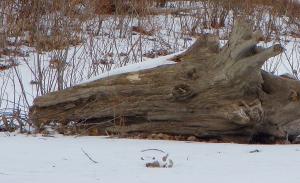| Fantasy Poetry posted January 11, 2016 | Chapters: |
...30 31 -32- 33... 
|
      |
A Sestet
A chapter in the book Animated Stills
The Dragon's Head
by Treischel
|
 Recognized |
This is an Animated Still of a driftwood tree trunk that reminds me of a Dragon's skull. I came across it along the Mississippi River. Dragon's bring to mind the legend of St. George. Since George is my middle name, I have always been interested in him. So, I thought I'd share some of his story here. Given the current Syrian refugee crisis, I thought a story about a Syrian Christian martyr appropriate.
Saint George (AD 275 to303), according to legend, was a soldier in the Roman army who later became venerated as a Christian martyr. His father, Gerontius, was a Roman army official from Cappadocia and his mother, Polychronia, was a Christian from Lydda in the Roman province of Syria, Palestine. Saint George became an officer in the Roman army under Emperor Diocletian, who ordered his death for failing to recant his Christian faith. But before that, he became renowned for many heroic exploits. As part of the Golden Legend, a dragon makes its nest at the spring that provides water for the city of Lydda in the Holy Land. Consequently, the citizens have to dislodge the dragon from its nest for a time, to collect water. To do so, each day they offer the dragon a sheep, and if no sheep can be found, then a maiden becomes the best substitute. The victim is chosen by drawing lots. One day, this happens to be the princess. She is offered to the dragon, but then Saint George appears on his travels. He faces the dragon, protects himself with the sign of the Cross, slays the dragon, and rescues the princess. The citizens abandon their ancestral paganism and convert to Christianity.
This poem is a Sestet.
Sestets are poems with six lines per stanza. They come in many formats. For this one, I use a cadence of :
8,8,8,8,8,10
The rhyme scheme follows the pattern:
aabbba in each, but does change the rhyme. It meter is iambic.
This photgraph was taken by the author himself on January 28, 2012.
Pays
one point
and 2 member cents. Saint George (AD 275 to303), according to legend, was a soldier in the Roman army who later became venerated as a Christian martyr. His father, Gerontius, was a Roman army official from Cappadocia and his mother, Polychronia, was a Christian from Lydda in the Roman province of Syria, Palestine. Saint George became an officer in the Roman army under Emperor Diocletian, who ordered his death for failing to recant his Christian faith. But before that, he became renowned for many heroic exploits. As part of the Golden Legend, a dragon makes its nest at the spring that provides water for the city of Lydda in the Holy Land. Consequently, the citizens have to dislodge the dragon from its nest for a time, to collect water. To do so, each day they offer the dragon a sheep, and if no sheep can be found, then a maiden becomes the best substitute. The victim is chosen by drawing lots. One day, this happens to be the princess. She is offered to the dragon, but then Saint George appears on his travels. He faces the dragon, protects himself with the sign of the Cross, slays the dragon, and rescues the princess. The citizens abandon their ancestral paganism and convert to Christianity.
This poem is a Sestet.
Sestets are poems with six lines per stanza. They come in many formats. For this one, I use a cadence of :
8,8,8,8,8,10
The rhyme scheme follows the pattern:
aabbba in each, but does change the rhyme. It meter is iambic.
This photgraph was taken by the author himself on January 28, 2012.

You need to login or register to write reviews. It's quick! We only ask four questions to new members.
© Copyright 2024. Treischel All rights reserved.
Treischel has granted FanStory.com, its affiliates and its syndicates non-exclusive rights to display this work.



